by Joanne Ivancic* (Advanced Biofuels USA) The Trump Administration is taking a new look at Obama Administration era Co2 regulations. On the transportation side, these include reviewing Corporate Average Fuel Economy (CAFE) standards; threatening to take away California’s authority to set their own mileage and pollution controls, including CO2 (carbon dioxide) emission reduction standards; and quarreling with the petroleum and biofuels industries over implementation and enforcement of the Renewable Fuel Standard (RFS).
Thus, the Clean Air Act (CAA), California's unique authority to regulate more stringently under a CAA provision, CAFE standards, the RFS and California's model Low Carbon Fuel Standards have been in the US national news a lot lately.
In some ways, all these activities are intertwined, especially in California, with a change in one having implications for others.
Ideally, all these federal programs should complement each other. Unfortunately, due to variations in interpretations regarding implementation and enforcement, that isn’t necessarily happening.
This article will review federal and state programs involved in improving the health and welfare in the US by regulating ground transportation, particularly cars and light duty trucks. It will track the policy paths that have converged in the conversations about a "midterm review," including recent litigation filed by California, 16 other states and the District of Columbia; and untangle some of the threads of various transportation and fuel interests.
Legislation History
Clean Air Act—Federal Responsibilities
The legal authority for federal programs regarding air pollution control is based on the Clean Air Act (CAA). The most recent amendments dating to 1990 (Clean Air Act Amendments (1990 CAAA)) modified and extended federal legal authority provided by the earlier Clean Air Acts of 1963 and 1970 and the 1977 Clean Air Act Amendments (1977 CAAA) regarding air pollution control.
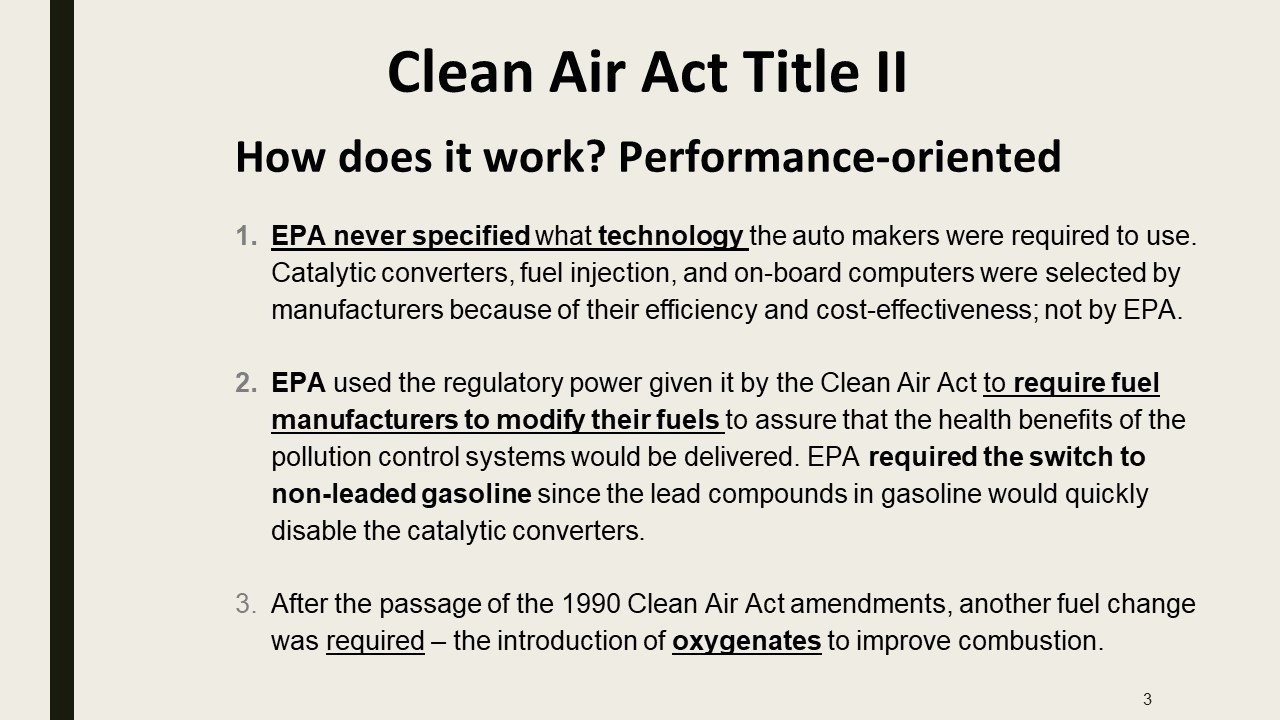 History
History
Because pollution was considered a health issue, from the beginning the U.S. Public Health Service was authorized to research techniques for monitoring and controlling air pollution.
Based on USPHS research and public outcry, the 1970 (1970 CAA) authorized the federal government to limit emissions from both stationary (industrial) sources and mobile sources (cars, trucks, transportation). The U.S. Environmental Protection Agency (EPA) was created on December 2, 1970, by the Nixon Administration, to implement and enforce these.
- Leaded to Unleaded
One new EPA national program phased out leaded gasoline in favor of unleaded to protect public health and welfare from the harmful effects of airborne lead and to accommodate the use of catalytic converters to clean up tailpipe emissions. By July 1974, within only four years of enactment, all major service stations had to offer unleaded gasoline.
Major amendments to the Clean Air Act in 1977 (1977 CAAA) added requirements pertaining to air pollution sources in geographic areas not meeting National Ambient Air Quality Standards (NAAQS), "non-attainment areas."
If leaders want to use policy to push the transition to renewable fuels (high octane fuels such as E30) to protect public health and welfare from the harmful effects of greenhouse gas emissions, the leaded-to-unleaded transition could serve as a model for implementation of that transition and for EPA to require availability of renewable fuels much as it required availability of unleaded gasoline.
Clean Air Act—California Authority
During the drafting of the 1970 Clean Air Act, California pointed to its decades of experience restricting tailpipe emissions as air pollution control measures; and to its unique air quality problems. Written into the 1970 CAA, California can ask the EPA administrator for a waiver to restrict tailpipe pollution from cars more stringently than the federal government. EPA shall grant a waiver unless it finds that California, under the Clean Air Act Section 209 – State Standards :
- was arbitrary and capricious in its finding that its standards are in the aggregate at least as protective of public health and welfare as applicable federal standards;
- does not need such standards to meet compelling and extraordinary conditions; or
- has proposed standards not consistent with Section 202(a) of the Clean Air Act.
EPA must approve this waiver before California’s rules may go into effect. Once California files a waiver request, EPA invites and reviews public comments then determines whether California has satisfied the law’s requirements.
This waiver process applies only to California, however, any other state can choose to adopt California’s more stringent standards. Thirteen states and the District of Columbia currently opt for the tougher rules. These "Section 177" states are: Connecticut, Delaware, Maine, Maryland, Massachusetts, New Jersey, New Mexico, New York, Oregon, Pennsylvania, Rhode Island, Vermont, and Washington. Arizona took itself off the list in 2012.
CAA waivers have been granted to California for 45 years. Most recently, in response to a 2005 request to the George W. Bush Administration, the Obama Administration’s EPA granted a waiver to California for regulations that added carbon dioxide (CO2) and other greenhouse gas emission standards for motor vehicles beginning with the 2009 model year.
This came after lengthy litigation.
In 2009, after the Supreme Court's 2007 finding that EPA had legal authority under the Clean Air Act to regulate carbon dioxide emissions, EPA granted California's 2005 waiver request. In 2012 the Supreme Court ruled that the Obama Administration’s EPA relied upon adequate scientific evidence when it found that carbon dioxide and similar “greenhouse gases” endanger public health and could be regulated under the Clean Air Act.
What is in California's current waiver? Legislated in 2006, California's greenhouse gas (GHG) emissions reduction program including the Low Carbon Fuel Standard, Advanced Clean Car (ACC) standards (Low Emission Vehicle (LEV) program and Zero Emission Vehicle (ZEV) program) and cap-and-trade program combine control of smog and soot causing pollutants and greenhouse gas emissions into a single coordinated package of requirements. This GHG package constitutes portions of California's implementation of it's current CAA waiver.
- Revoking California’s Current Waiver
As the Trump Administration reviews California's CAA waiver, it might seem that one way that the current EPA might revoke California’s waiver would be to find, from reviewing scientific evidence, that CO2 and other greenhouse gases or pollutants previously regulated no longer cause harm to the public health or welfare.
However, the Clean Air Act includes no mechanism for revoking a waiver.
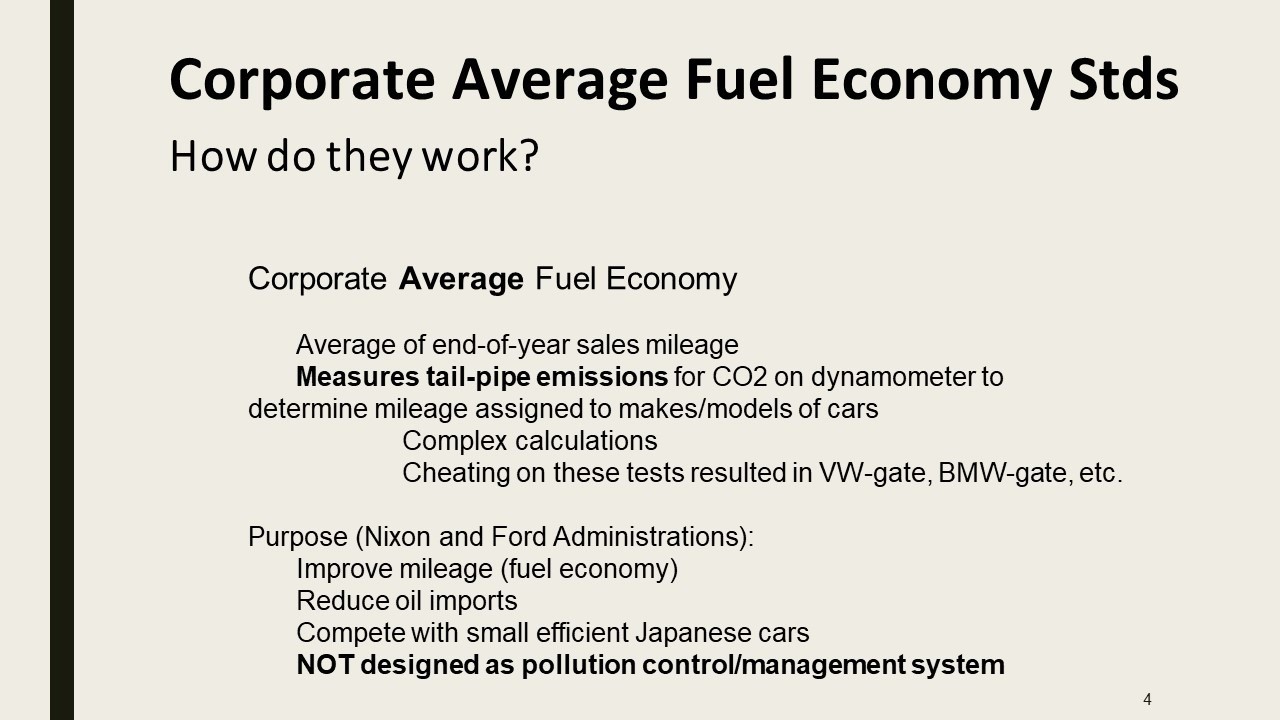 Corporate Average Fuel Economy Standards (CAFE)
Corporate Average Fuel Economy Standards (CAFE)
In response to the 1973 oil embargo, to reduce use of petroleum transportation fuel, especially imported petroleum fuel, and to encourage US vehicles to be more competitive with Japanese products, Congress passed the Energy Policy and Conservation Act (EPCA) of 1975, which established fuel economy standards that manufacturers’ fleets must meet for new passenger cars starting with model year (MY) 1978. These Corporate Average Fuel Economy (CAFE) standards prescribed mileage or fuel economy goals, as an average of new car sales.
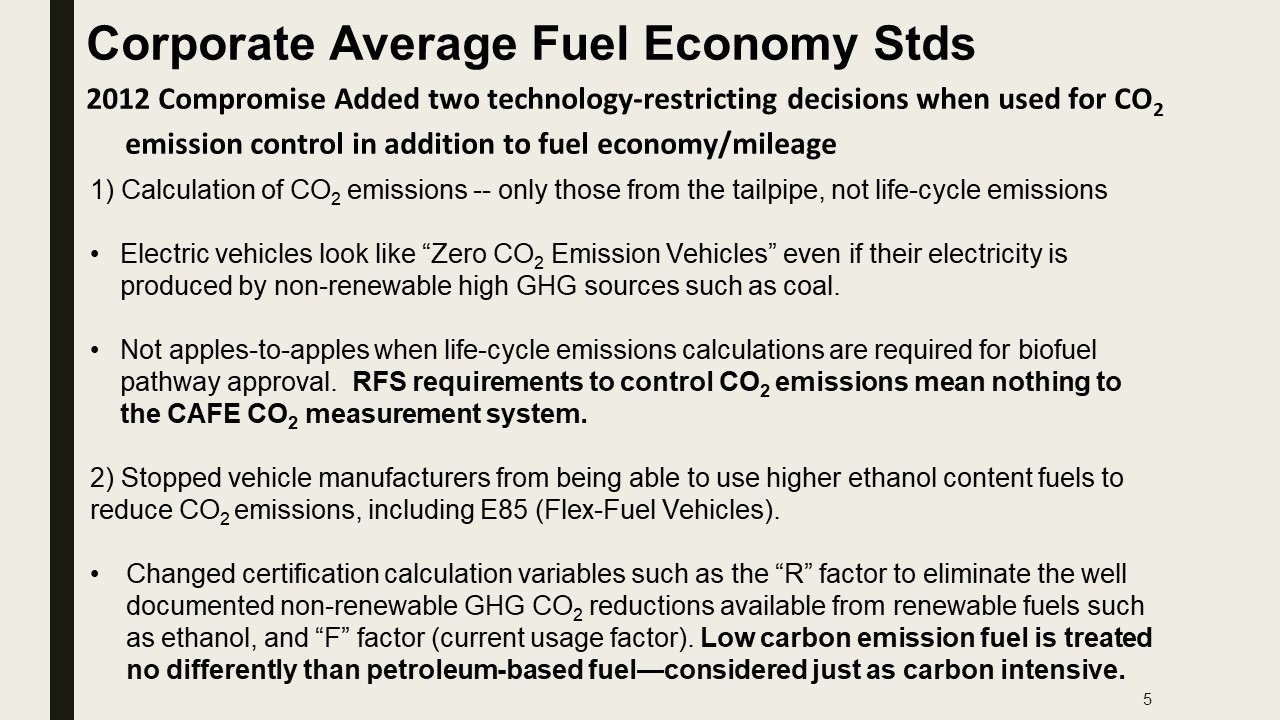 The Department of Transportation’s National Highway Traffic and Safety Administration (NHTSA), charged with administering this program, also established CAFE standards for light trucks (i.e., pickups, minivans, and SUVs) beginning with MY 1978.
The Department of Transportation’s National Highway Traffic and Safety Administration (NHTSA), charged with administering this program, also established CAFE standards for light trucks (i.e., pickups, minivans, and SUVs) beginning with MY 1978.
In 2007, the Energy Independence and Security Act of 2007, raised the fuel economy standards of US cars, light trucks, and SUVs to a combined average of at least 35 miles per gallon by 2020 and required standards to be met at maximum feasible levels through 2030.
In 2012, NHTSA established final passenger car and light truck CAFE standards for model years 2017-2021. NHTSA predicts for model year 2021, on average, a combined fleet-wide fuel economy of 40.3-41.0 mpg.
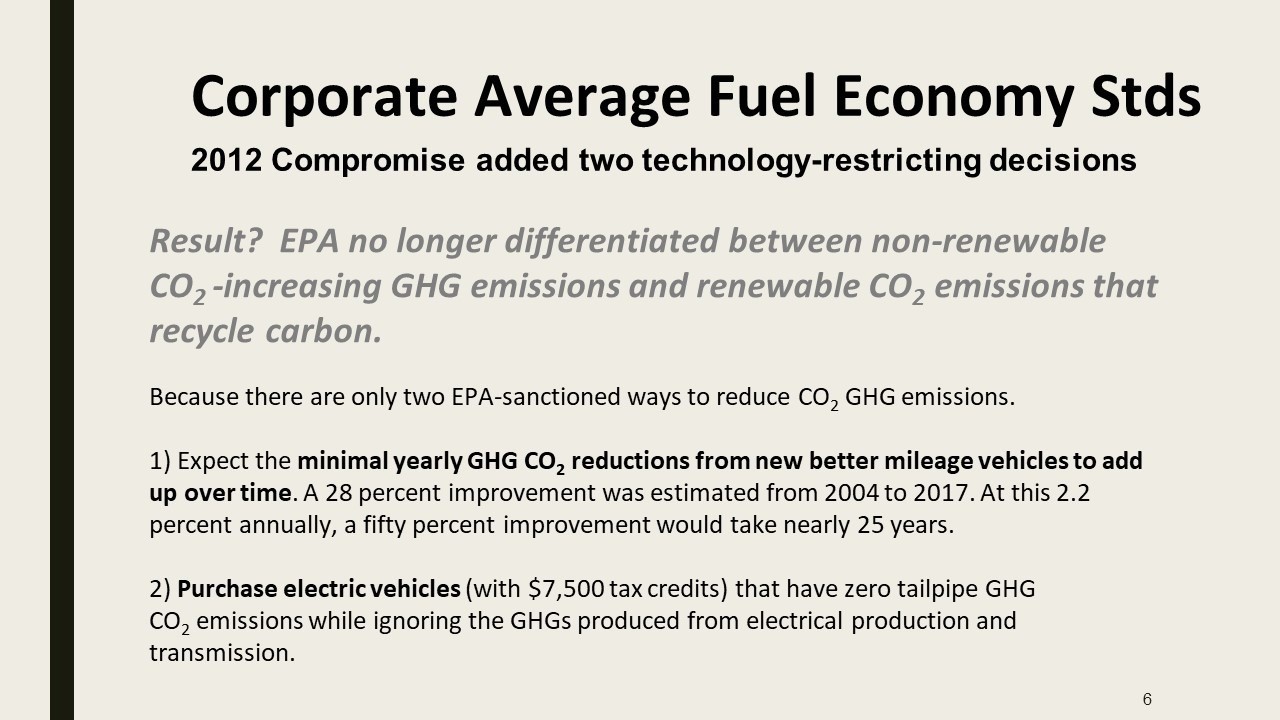 These CAFE standards were included as part of the 2012 compromise which acknowledged California's GHG ( LCFS, ZEV and LEV) programs even though the EPCA of 1975 specifically precludes granting California or any other state a waiver from federal fuel economy/mileage standards.
These CAFE standards were included as part of the 2012 compromise which acknowledged California's GHG ( LCFS, ZEV and LEV) programs even though the EPCA of 1975 specifically precludes granting California or any other state a waiver from federal fuel economy/mileage standards.
The EPCA states, "When an average fuel economy standard prescribed under this chapter is in effect, a State or a political subdivision of a State may not adopt or enforce a law or regulation related to fuel economy standards or average fuel economy standards for automobiles covered by an average fuel economy standard under this chapter."
The Trump Administration is reviewing whether California's 2012 waiver covered CAFE regulations and if that violates the EPCA.
Some changes made to the CAFE standards during the 2012 negotiations moved them toward the EV-biased California regulations.
For example, prior to MY2020, manufacturers were encouraged to produce flex fuel vehicles (FFVs) that could use home-grown high ethanol fuel blends such as E85 (50-85% ethanol) as a way to reduce use of imported fuel. This was incorporated into fuel economy calculations with the “F-Factor.”
The F-Factor has only been determined through MY 2018. Absent a new determination by EPA, the F-Factor for MY 2019 and subsequent years will default to zero resulting in the elimination of crediting for FFVs. As a result, automakers are phasing down FFV manufacturing. This trend runs counter to increasing success in the market with more E85 and flex fuel blender pumps being installed around the country improving access to these fuels; Department of Energy and other studies finding that mileage improvements can be achieved using engines designed for high octane/high ethanol fuel blends; and proposed regulations (REGS Rule or Renewables Enhancement and Growth Support Rule) to limit use of fuels containing more than 15% ethanol to FFVs.
The fuel economy calculation’s “R-Factor” was supposed to enable apples-to-apples comparisons of fuel economy despite changes in the energy density of E0 or E10 test fuel and E85 test fuel. EPA has admitted that the R-factor is inaccurate for today’s vehicles with turbo charged, computer controlled engines and promised in 2012 that it would fix this problem “in a timely manner,” although it has not yet done so.
2012 Compromise -- Bringing together CAA, CAFE and California CAA into One National Program
In the wake of the Supreme Court’s 2007 confirmation of EPA’s authority to regulate greenhouse gases, stakeholders (NHTSA, EPA, automakers, United Auto Workers, consumer groups, environmental and energy experts, states (particularly California), and the public) weighed in on the Obama Administration’s work to establish both emissions regulations under the CAA and mileage standards under CAFE in an integrated program.
In the final 2012 rules, EPA, NHTSA and California announced a “harmonized” national pollution control and fuel economy program.
Because testing CO2 tailpipe emissions were part of EPA’s vehicle tests related to mileage (fuel economy) under CAFE, instead of setting new procedures designed to analyze pollution similar to those designed for other CAA pollutants (carbon monoxide, nitrogen oxides, etc.), NHTSA, EPA and California decided to use just the CAFE tailpipe mileage test procedures to assess both mileage and pollution.
Thus, vehicles that have no tailpipes appear, for purposes of CAA pollution assessment, to emit no emissions from energy used to power the vehicles. For example, there is no assessment at all of pollution from electricity produced (from coal, natural gas, biomass, etc.) to power electric vehicles.
In a strange twist, this new "harmonized" system allowed pollution standards, which under previous CAA regulations had to be met by every vehicle class, now, for CO2 using CAFE procedures, could be spread across a manufacturer’s fleet. Thus, vehicles with no tailpipes might balance out heavy tailpipe polluting vehicles where previously each vehicle class had to meet standards.
To prevent the unwanted result of the "no tailpipe emissions" EVs balancing out high-CO2-tailpipe polluting/low mileage vehicles, the auto manufacturers agreed to the 54.5 MPG CAFE goals, with a midterm evaluation, due in April 2018, to determine if this was a fair compromise.
Also as a part of this "harmonization" incentives for design and production of engines and fuels which produce low life cycle pollution have been decimated. Lack of the F-Factor and R-Factor and lack of life cycle comparisons of actual transportation power sources prevents vehicle manufacturers from taking advantage of the characteristics of biofuels, such as high octane/high ethanol blends.
In effect, CAFE regulations were modified to encourage and give preference to EVs.
And, instead of taking the original CAA approach of setting pollution control performance objectives and letting the transportation industry develop optimal ways to achieve the goals, the 2012 regulatory system gives electric vehicles an advantage that circumvents the intent of the pollution control policies of the CAA by not counting pollution from their power sources.
As to the numbers, in 2012 EPA determined that new passenger cars and light duty trucks CAA pollution emissions would be limited to 163 grams CO2 per mile (g/mi) in model year 2025. This was determined to be equivalent to 54.5 miles per gallon (mpg) for CAFE standard assessment, if the standards were met exclusively with fuel efficiency improvements.
As a result of the blended, double purpose effect of the CO2 measurements to meet fuel economy AND emissions control goals, California's CAA waiver appears to serve also as a CAFE waiver.
This may provide the Trump Administration a justification for unraveling the 2012 compromise and effectively withdrawing California's waiver due to the EPCA's prohibition of states regulating fuel economy standards.
- 2017-8 -- Tearing Apart the CAA, CAFE and California CAA Waiver Regulations -- Role of RFS and LCFS
In January 2017, a few days before President Barack Obama left office, the EPA announced the conclusion of the midterm review, finding “the greenhouse gas emissions standards for cars and light trucks remain affordable and effective through 2025.”
However, in March 2017, the Trump Administration's EPA and Department of Transportation re-opened the midterm evaluation process and in April 2018, EPA Administrator Scott Pruitt announced that EPA found the current standards not appropriate and EPA's intent to revise them, to re-evaluate California’s CAA waiver and the coordinated national standard (2012 compromise) that combined the CAFE, CAA and California GHG regulations.
In turn, California and 16 others states and the District of Columbia have filed a petition for review of EPA's recent actions related to the midterm review agreed to in the 2012 CAFE stakeholder compromise. Separately, a number of environmental organizations have also filed a petition for review of the EPA withdrawal of Mid-Term Evaluation of Greenhouse Gas Emissions Standards for Model Year 2022-2025 Light-Duty Vehicles
- 2012 Federal Regulations Confounding Policy Goals of Renewable Fuel Standard (RFS) and California’s Low Carbon Fuels Standards
The 2012 “harmonization” resulted in not only in circumventing a key purpose of the Clean Air Act, to reduce harmful pollutants from every vehicle's transportation emissions, particularly as applied to newly recognized greenhouse gas, CO2; but also circumvented the policy goals of the federal Renewable Fuel Standard (RFS).
At the federal level, to achieve President George W. Bush’s policy to “get off our addiction to (high priced) oil” the focus on incentivizing engine efficiency (CAFE) expanded to incentivizing a transition away from petroleum transportation fuel via the Renewable Fuel Standard (RFS).
The Energy Policy Act of 2005 created the RFS which was expanded in the Energy Independence and Security Act of 2007 (EISA) that also raised CAFE goals to 35 mpg. Provisions in the EISA also promoted sustainability criteria (particularly indirect land use change) for renewable fuels, also included in California’s Low Carbon Fuel Standard (LCFS).
Renewable Fuel Standard, MTBE, History and Objectives
Even before the RFS, due to ethanol's properties as a non-toxic oxygenate and for its low-cost octane properties, ethanol was on the way to be used as 10% of gasoline blends.
After the transition from leaded to unleaded gasoline was complete, the 1990 Clean Air Act amendments required another fuel change in non-attainment areas, the introduction of oxygenates to improve combustion and reduce emissions.
In the early 1990s, petroleum refiners, based on their own research, decided to use the petroleum additive, MTBE (Methyl Tertiary Butyl Ether) for this purpose. However, MTBE, a persistent carcinogen, was eventually found in water supplies near leaking fuel tanks. MTBE does not break down readily; it does not go away. Lawsuits ensued. In the early 2000s, states began to ban MTBE.
In order to stop the health hazards of MTBE while also retaining the low-emission benefits of oxygenates, EPA allowed ethanol to be used as a safe, effective substitute oxygenate. Beginning in 2004 refiners chose to replace MTBE in US gasoline with ethanol at 10% blends (E10), using this more economical ethanol first in the non-attainment areas, then across the US as oil companies found that ethanol's high octane value enabled them to make less expensive 85 octane gasoline blendstock.
Legislation enabled the Environmental Protection Agency to accommodate E10’s higher Reid Vapor Pressure (RVP) characteristics, the “one pound waiver.” Oil refiners, finding ethanol a less expensive alternative to MTBE, had no reason to fight this legislation. Corn growers diversified into ethanol production obtaining a market for corn that enabled prices to rise enough to avoid the need for government subsidies.
EPA's current interpretation of this specific "E10" legislative language, is to create a barrier to permitting E15 (15 percent ethanol) to gain market share, even though E15 has lower RVP than E10. However, as the statute applies to all fuels containing gasoline and 10% ethanol, that language is broad enough to encompass blends with more than 10% ethanol, and EPA can revise its interpretation and promulgate a revised rule.
Although E10 would have become standard regular gasoline (87 octane) in the US due to the transition from MTBE, when Congress wanted to make an effort to “go green” it passed the Renewable Fuel Standard as part of the Energy Policy Act of 2005 and legislated 10 percent ethanol into the retail fuel market.
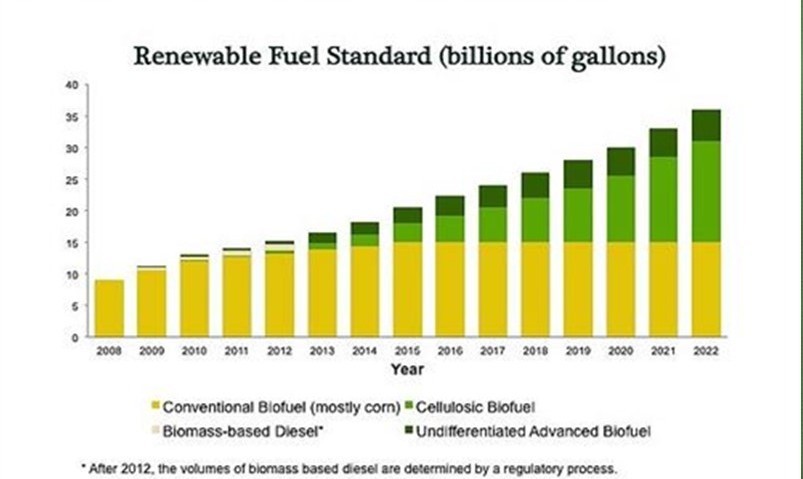 Again, anticipating increasing markets for gasoline, and recognizing the economic benefit of using less expensive ethanol for oxygenate and octane, the petroleum industry had no cause to oppose this 2005 legislation.
Again, anticipating increasing markets for gasoline, and recognizing the economic benefit of using less expensive ethanol for oxygenate and octane, the petroleum industry had no cause to oppose this 2005 legislation.
However, amid concerns about rising oil prices ($60 in August 2005 rising to $147.30 in July 2008), Congress passed the Energy Independence and Security Act of 2007 expanding the RFS to include advanced biofuels, cellulosic biofuels, bio-based diesel and effectively limiting corn starch-derived ethanol to the 10% of the anticipated market that it “owned” from RFS1.
The established oil industry generally was not happy about this expansion which was designed to replace petroleum with renewables, although some explored diversifying into renewable fuels for a few years and others, like Valero and the Koch Industry's Flint Hills Resources, continue to own and operate ethanol biorefineries.
Life cycle “seed-to-wheel” analysis of renewable fuels compared to the legislative baseline of 2005 “well-to-wheel” petroleum constitutes an integral part of the definitions and criteria for eligible renewable fuels. Controversial sustainability criteria, international indirect land use change (ILUC), were also added to the legislation.
With more wishful optimism than scientific evidence, the RFS2 legislation set annual goals for transitioning from petroleum to advanced biofuels. No funding was provided in this legislation for research, development, production or deployment of advanced biofuels to achieve the goals. With oil prices rising, the oil industry and private investors were expected to fund the transition to this exciting new energy industry. Indeed, national conferences after the legislation passed were packed with investment firms, oil majors, transaction lawyers, agricultural interests, researchers and others interested in environmental improvements to transportation.
A system of tradeable/sellable renewable identification numbers (RINs) was designed to track accomplishment of the RFS goals.
At the same time, news articles and future-oriented studies based on economic modeling began to appear which predicted harsh environmental consequences of moving from petroleum to renewable liquid fuel. In particular, Tim Searchinger's disproved predictions which continue to receive attention.
California’s Low Carbon Fuel Standard – Focus on Life Cycle CO2 Emissions for Liquid Fuel
In 2006, California, more concerned with climate change mitigation and preventing in-state air pollution than finding home-grown substitutes for expensive foreign oil, passed Low Carbon Fuel Standard (LCFS) legislation as part of the GHG package.
LCFS implementation focuses on life cycle analysis of liquid transportation fuel measured as “carbon intensity” (CI) of gasoline and diesel fuel and their respective substitutes.
Initially intending to reduce greenhouse gas emissions to 1990 levels by the year 2020, California’s LCFS serves as a model to not only other US states and Canadian provinces, but to other countries, such as Brazil, establishing climate change mitigation strategies. California’s Air Resources Board is in the process of extending LCFS carbon intensity reductions to 20% below 2011 levels by 2030.
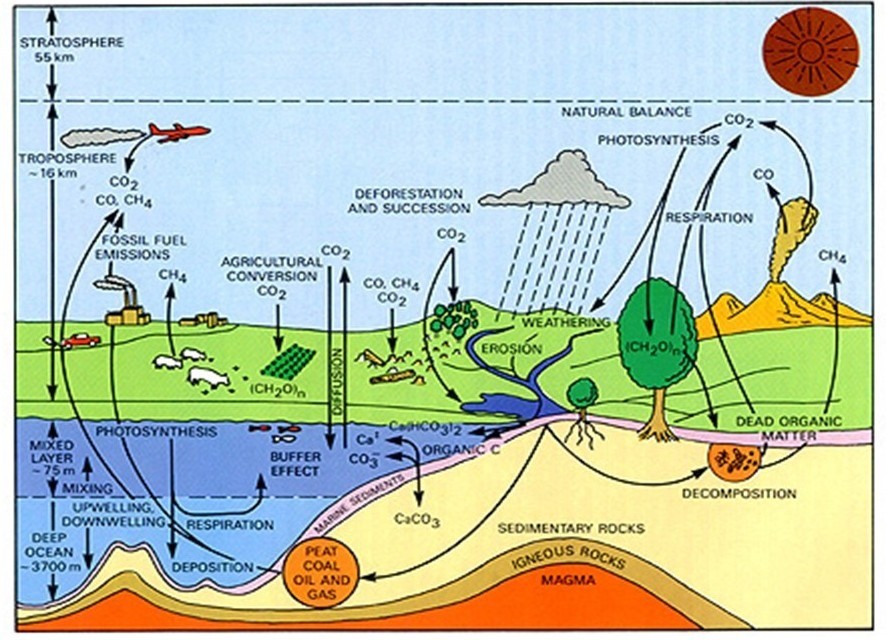 The California Air Resources Board (CARB) describes the technology-neutral program as “performance-based and fuel-neutral, allowing the market to determine how the carbon intensity of California's transportation fuels will be reduced. This program is based on the principle that each fuel has "lifecycle" greenhouse gas emissions that include CO2, N2O, and other greenhouse gas contributors." This lifecycle assessment using the GREET model (Greenhouse Gases, Regulated Emissions, and Energy Use in Transportation) developed by Argonne National Laboratory examines the greenhouse gas emissions associated with the production, transportation, and use of a given fuel. "The lifecycle assessment includes direct emissions associated with producing, transporting, and using the fuels, as well as significant indirect effects on greenhouse gas emissions, such as changes in land use for some biofuels.” CI is expressed in grams of CO2 equivalent per mega joule (gCO2e/MJ or g/MJ for short).
The California Air Resources Board (CARB) describes the technology-neutral program as “performance-based and fuel-neutral, allowing the market to determine how the carbon intensity of California's transportation fuels will be reduced. This program is based on the principle that each fuel has "lifecycle" greenhouse gas emissions that include CO2, N2O, and other greenhouse gas contributors." This lifecycle assessment using the GREET model (Greenhouse Gases, Regulated Emissions, and Energy Use in Transportation) developed by Argonne National Laboratory examines the greenhouse gas emissions associated with the production, transportation, and use of a given fuel. "The lifecycle assessment includes direct emissions associated with producing, transporting, and using the fuels, as well as significant indirect effects on greenhouse gas emissions, such as changes in land use for some biofuels.” CI is expressed in grams of CO2 equivalent per mega joule (gCO2e/MJ or g/MJ for short).
Like the CAA, the LCFS regulates greenhouse gas emissions (CO2, N2O, and others) and smog-forming and toxic air pollutants, but with a focus on fuels.
Under the LCFS, the carbon intensity of the underlying power is included in the CI score of the pathway. California grid mix electricity is comparable from a carbon intensity perspective to both gasoline and diesel fuel (about 100 g CO2e/MJ). However, EV's get a credit boost attributed to energy efficiency. This provides a multiplier impact on LCFS credit generation. Amendments to this program are currently under consideration.
Real Harmonization: CAA, CAFE, CAA waiver, LCFS and RFS
Graham Noyes of the Low Carbon Fuels Coalition and Doug Durante of the Clean Fuels Development Coalition suggested how to harmonize the EPA, NHTSA and CARB programs in a recent Biofuels Digest article.
They suggest “The specific regulatory mechanical fixes necessary are for EPA to extend the current usage factor (known as the F-factor) to MY 2019 and beyond, and for EPA and NHTSA to harmonize the crediting for FFV manufacturing under the CAFE and GHG programs. We also need to fix the so-called R factor which currently penalizes ethanol blends for a mileage loss. And finally, however one chooses to use ethanol, the carbon footprint of ethanol is demonstrably better than the power sources for EVs. Ethanol should therefore be treated as carbon neutral as is already the case for EV power. These changes can be implemented quickly and easily, will enhance automaker compliance with the standards and save money, and can be calibrated to recognize real world GHG and petroleum reductions. The FFV mechanisms can also be crafted to facilitate the CAFE and GHG crediting of high efficiency vehicles that utilize high octane fuels.”
Advanced Biofuels USA Proposal: Regulate Actual Life Cycle CO2 Emissions to Achieve Greater Near-Term CO2 Reduction Goals
By recognizing the low life cycle carbon emissions, low toxic emissions benefits, and engine efficiency gains of renewable fuels in the Clean Air Act and Corporate Average Fuel Economy Standards, along with California’s CAA waiver and Low Carbon Fuel Standards programs, the investment anticipated as the driver to fulfill the RFS goals could be achieved. And, true realization of the pollution control policy goals of the Clean Air Act would also be achieved.
Here’s how.
- Keep the motor vehicle CO2 reduction goals in place.
- Do not apply the CAFE regulatory approach (average for fuel economy) to calculate compliance with emissions standards.
- Get rid of EPA restrictions on technologies.
- Use the existing gram/mile approach to measure and regulate fuel economy for various vehicle classes.
- Restore renewable fuel GHG reduction variables in fuel efficiency calculations.
- Use higher ethanol and other renewable fuel blends to reduce non-renewable GHG CO2 emissions instead of more expensive vehicle weight reduction strategies.
- Base new ethanol mixtures on blends shown to produce performance and GHG reduction by US National Labs for both existing lower performance and new high efficiency engines. (3)
- Base ethanol and other renewable blends on results from vehicle manufacturers that improve the mileage and performance of small-displacement, high efficiency turbocharged engines such as the eco-boost. (4)
Instead of working at counter-purposes, federal and California laws, regulations and policies could work in true harmony to achieve truthful, measurable reduction in greenhouse gas emissions that result from light duty ground transportation.
Instead of evading the pollution-control procedures of the CAA that should apply to each and every vehicle and that should reflect the true pollution caused by cars and light duty vehicles, the CAA should be embraced with the intention that, just as the RFS was a way to push transition away from liquid fossil fuels, the CAA when applied to electric vehicles should push the transition toward renewable electricity.
Trying to twist the regulations, to turn procedures inside out and backwards works against making the air cleaner, mitigating climate change and driving transportation into a renewables-based future.
(1) Martinez, Michael, Automotive News, Ford rushes to build more SUVs, February 12, 2018 http://www.autonews.com/article/20180212/RETAIL01/180219953/ford-suv-production and Thibodeau, Ian, The Detroit News, Ford marshals reinforcements for SUV production, February 12, 2018 http://www.detroitnews.com/story/business/autos/ford/2018/02/12/ford-boosts-navigator-expedition-production/110331592/
(2) Tsui, Chris, The Drive, The Ford Fiesta Is Dead in America, July 23, 2017 http://www.thedrive.com/news/12773/the-ford-fiesta-is-dead-in-america
(3) West, Brian, Group Leader, Fuels, Engines, and Emissions Research Group, Oak Ridge National Lab (ORNL), Can Fuel Efficiency Standards Be Met Cost-Effectively? and Future Fuels: Can Biofuels Make Gasoline Cleaner, Cheaper? View Video | Download Slides
Breakthrough Research in Engine and Fuel Co-Optimization (U.S. Department of Energy)
(4) Ford Motor Company: Literature Review of Benefits of High Octane/High Ethanol Fuels
For more details on these ideas, see “Let’s Regulate CO2 Emissions, and Forget the 55.4 MPG 2025 Corporate Annual Fuel Economy Standard: The Inexpensive Way to Quickly Reduce Green House Gases” by Robert Kozak.
*Joanne Ivancic serves as the executive director of Advanced Biofuels USA. Any opinions expressed in his article reflect her views, not the views of Advanced Biofuels USA.
Revised article 5/25/2018
Reprinted in Biofuels Digest 5/29/2018
CALIFORNIA GETS CHARGED UP FOR EVs (Politico's Morning Energy)
FUTURE FOR MID-LEVEL BLENDS HANGS IN THE BALANCE WITH PROPOSED CAFE RULE (Minnesota Bio-Fuels Association)
UPDATE 1-Trump administration, California meet on vehicle emissions (Reuters)
Excerpt from Politico's Morning Energy: The California Public Utilities Commission is expected to approve a $589 million program for its four investor-owned utilities to build out their electric vehicle charging infrastructure. The plan is part of the implementation of California's aggressive greenhouse gas law passed in 2015. Most of the money — which will ultimately come from ratepayers — will go toward setting up electric vehicle charging stations and related infrastructure. California leads the nation by far in electric vehicle sales and adoption. READ MORE
Except from Minnesota Bio-Fuels Association: The EPA and Department of Transportation’s proposal to freeze Corporate Average Fuel Economy (CAFE) standards at 2020 levels could derail a promising future for mid-level blends of ethanol.
The lynch pin for mid-level blends of ethanol, ranging from 25 percent to 40 percent, was the CAFE Standard which had set targets for higher fuel economy for cars by 2025. The Department of Energy (DOE) has previously said that vehicles equipped with high compression ratio engines that use the high octane ethanol blends mentioned above would achieve higher mileage while reducing emissions.
But the proposed CAFE rule takes the pressure off automakers to use such advanced engine technology which would have paved the way for higher blends of ethanol.
Nonetheless, in the proposed rule, reference is made to comments from proponents, including the Minnesota Bio-Fuels Association, of using mid-level ethanol blends to achieve higher fuel economy.
It should be noted that this reference does not give a green light to mid-level blends but rather sets forth an issue for which additional input is sought from all parties to the matter, including proponents and opponents of higher ethanol blends. READ MORE
Nearly 55,000 articles in our online library!
Use the categories and tags listed below to access the nearly 50,000 articles indexed on this website.
Advanced Biofuels USA Policy Statements and Handouts!
- For Kids: Carbon Cycle Puzzle Page
- Why Ethanol? Why E85?
- Just A Minute 3-5 Minute Educational Videos
- 30/30 Online Presentations
- “Disappearing” Carbon Tax for Non-Renewable Fuels
- What’s the Difference between Biodiesel and Renewable (Green) Diesel? 2020 revision
- How to De-Fossilize Your Fleet: Suggestions for Fleet Managers Working on Sustainability Programs
- New Engine Technologies Could Produce Similar Mileage for All Ethanol Fuel Mixtures
- Action Plan for a Sustainable Advanced Biofuel Economy
- The Interaction of the Clean Air Act, California’s CAA Waiver, Corporate Average Fuel Economy Standards, Renewable Fuel Standards and California’s Low Carbon Fuel Standard
- Latest Data on Fuel Mileage and GHG Benefits of E30
- What Can I Do?
Donate
DonateARCHIVES
- December 2025
- November 2025
- October 2025
- September 2025
- August 2025
- July 2025
- June 2025
- May 2025
- April 2025
- March 2025
- February 2025
- January 2025
- December 2024
- November 2024
- October 2024
- September 2024
- August 2024
- July 2024
- June 2024
- May 2024
- April 2024
- March 2024
- February 2024
- January 2024
- December 2023
- November 2023
- October 2023
- September 2023
- August 2023
- July 2023
- June 2023
- May 2023
- April 2023
- March 2023
- February 2023
- January 2023
- December 2022
- November 2022
- October 2022
- September 2022
- August 2022
- July 2022
- June 2022
- May 2022
- April 2022
- March 2022
- February 2022
- January 2022
- December 2021
- November 2021
- October 2021
- September 2021
- August 2021
- July 2021
- June 2021
- May 2021
- April 2021
- March 2021
- February 2021
- January 2021
- December 2020
- November 2020
- October 2020
- September 2020
- August 2020
- July 2020
- June 2020
- May 2020
- April 2020
- March 2020
- February 2020
- January 2020
- December 2019
- November 2019
- October 2019
- September 2019
- August 2019
- July 2019
- June 2019
- May 2019
- April 2019
- March 2019
- February 2019
- January 2019
- December 2018
- November 2018
- October 2018
- September 2018
- August 2018
- July 2018
- June 2018
- May 2018
- April 2018
- March 2018
- February 2018
- January 2018
- December 2017
- November 2017
- October 2017
- September 2017
- August 2017
- July 2017
- June 2017
- May 2017
- April 2017
- March 2017
- February 2017
- January 2017
- December 2016
- November 2016
- October 2016
- September 2016
- August 2016
- July 2016
- June 2016
- May 2016
- April 2016
- March 2016
- February 2016
- January 2016
- December 2015
- November 2015
- October 2015
- September 2015
- August 2015
- July 2015
- June 2015
- May 2015
- April 2015
- March 2015
- February 2015
- January 2015
- December 2014
- November 2014
- October 2014
- September 2014
- August 2014
- July 2014
- June 2014
- May 2014
- April 2014
- March 2014
- February 2014
- January 2014
- December 2013
- November 2013
- October 2013
- September 2013
- August 2013
- July 2013
- June 2013
- May 2013
- April 2013
- March 2013
- February 2013
- January 2013
- December 2012
- November 2012
- October 2012
- September 2012
- August 2012
- July 2012
- June 2012
- May 2012
- April 2012
- March 2012
- February 2012
- January 2012
- December 2011
- November 2011
- October 2011
- September 2011
- August 2011
- July 2011
- June 2011
- May 2011
- April 2011
- March 2011
- February 2011
- January 2011
- December 2010
- November 2010
- October 2010
- September 2010
- August 2010
- July 2010
- June 2010
- May 2010
- April 2010
- March 2010
- February 2010
- January 2010
- December 2009
- November 2009
- October 2009
- September 2009
- August 2009
- July 2009
- June 2009
- May 2009
- April 2009
- March 2009
- February 2009
- January 2009
- December 2008
- November 2008
- October 2008
- September 2008
- August 2008
- July 2008
- June 2008
- May 2008
- April 2008
- March 2008
- February 2008
- January 2008
- December 2007
- November 2007
- October 2007
- September 2007
- August 2007
- June 2007
- February 2007
- January 2007
- October 2006
- April 2006
- January 2006
- April 2005
- December 2004
- November 2004
- December 1987
CATEGORIES
- About Us
- Advanced Biofuels Call to Action
- Aviation Fuel/Sustainable Aviation Fuel (SAF)
- BioChemicals/Renewable Chemicals
- BioRefineries/Renewable Fuel Production
- Business News/Analysis
- Cooking Fuel
- Education
- 30/30 Online Presentations
- Competitions, Contests
- Earth Day 2021
- Earth Day 2022
- Earth Day 2023
- Earth Day 2024
- Earth Day 2025
- Executive Training
- Featured Study Programs
- Instagram TikTok Short Videos
- Internships
- Just a Minute
- K-12 Activities
- Mechanics training
- Online Courses
- Podcasts
- Scholarships/Fellowships
- Teacher Resources
- Technical Training
- Technician Training
- University/College Programs
- Events
- Coming Events
- Completed Events
- More Coming Events
- Requests for Speakers, Presentations, Posters
- Requests for Speakers, Presentations, Posters Completed
- Webinars/Online
- Webinars/Online Completed; often available on-demand
- Federal Agency/Executive Branch
- Agency for International Development (USAID)
- Agriculture (USDA)
- Commerce Department
- Commodity Futures Trading Commission
- Congressional Budget Office
- Defense (DOD)
- Air Force
- Army
- DARPA (Defense Advance Research Projects Agency)
- Defense Logistics Agency
- Marines
- Navy
- Education Department
- Energy (DOE)
- Environmental Protection Agency
- Federal Energy Regulatory Commission (FERC)
- Federal Reserve System
- Federal Trade Commission
- Food and Drug Administration
- General Services Administration
- Government Accountability Office (GAO)
- Health and Human Services (HHS)
- Homeland Security
- Housing and Urban Development (HUD)
- Interior Department
- International Trade Commission
- Joint Office of Energy and Transportation
- Justice (DOJ)
- Labor Department
- National Academies of Sciences Engineering Medicine
- National Aeronautics and Space Administration
- National Oceanic and Atmospheric Administration
- National Research Council
- National Science Foundation
- National Transportation Safety Board (NTSB)
- Occupational Safety and Health Administration
- Overseas Private Investment Corporation
- Patent and Trademark Office
- Securities and Exchange Commission
- State Department
- Surface Transportation Board
- Transportation (DOT)
- Federal Aviation Administration
- National Highway Traffic Safety Administration (NHTSA)
- Pipeline and Hazardous Materials Safety Admin (PHMSA)
- Treasury Department
- U.S. Trade Representative (USTR)
- White House
- Federal Legislation
- Federal Litigation
- Federal Regulation
- Feedstocks
- Agriculture/Food Processing Residues nonfield crop
- Alcohol/Ethanol/Isobutanol
- Algae/Other Aquatic Organisms/Seaweed
- Atmosphere
- Carbon Dioxide (CO2)
- Field/Orchard/Plantation Crops/Residues
- Forestry/Wood/Residues/Waste
- hydrogen
- Manure
- Methane/Biogas
- methanol/bio-/renewable methanol
- Not Agriculture
- RFNBO (Renewable Fuels of Non-Biological Origin)
- Seawater
- Sugars
- water
- Funding/Financing/Investing
- grants
- Green Jobs
- Green Racing
- Health Concerns/Benefits
- Heating Oil/Fuel
- History of Advanced Biofuels
- Infrastructure
- Aggregation
- Biofuels Engine Design
- Biorefinery/Fuel Production Infrastructure
- Carbon Capture/Storage/Use
- certification
- Deliver Dispense
- Farming/Growing
- Precursors/Biointermediates
- Preprocessing
- Pretreatment
- Terminals Transport Pipelines
- International
- Abu Dhabi
- Afghanistan
- Africa
- Albania
- Algeria
- Angola
- Antarctica
- Arctic
- Argentina
- Armenia
- Aruba
- Asia
- Asia Pacific
- Australia
- Austria
- Azerbaijan
- Bahamas
- Bahrain
- Bangladesh
- Barbados
- Belarus
- Belgium
- Belize
- Benin
- Bermuda
- Bhutan
- Bolivia
- Bosnia and Herzegovina
- Botswana
- Brazil
- Brunei
- Bulgaria
- Burkina Faso
- Burundi
- Cambodia
- Cameroon
- Canada
- Caribbean
- Central African Republic
- Central America
- Chad
- Chile
- China
- Colombia
- Congo
- Congo, Democratic Republic of
- Costa Rica
- Croatia
- Cuba
- Cyprus
- Czech Republic
- Denmark
- Dominican Republic
- Dubai
- Ecuador
- El Salvador
- Equatorial Guinea
- Eqypt
- Estonia
- Eswatini/Swaziland
- Ethiopia
- European Union (EU)
- Fiji
- Finland
- France
- French Guiana
- Gabon
- Georgia
- Germany
- Ghana
- Global South
- Greece
- Greenland
- Grenada
- Guatemala
- Guinea
- Guyana
- Haiti
- Honduras
- Hong Kong
- Hungary
- Iceland
- India
- Indonesia
- Iran
- Iraq
- Ireland
- Israel
- Italy
- Ivory Coast
- Jamaica
- Japan
- Jersey
- Jordan
- Kazakhstan
- Kenya
- Korea
- Kosovo
- Kuwait
- Laos
- Latin America
- Latvia
- Lebanon
- Liberia
- Lithuania
- Luxembourg
- Macedonia
- Madagascar
- Malawi
- Malaysia
- Maldives
- Mali
- Malta
- Marshall Islands
- Mauritania
- Mauritius
- Mexico
- Middle East
- Moldova
- Monaco
- Mongolia
- Morocco
- Mozambique
- Myanmar/Burma
- Namibia
- Nepal
- Netherlands
- New Guinea
- New Zealand
- Nicaragua
- Niger
- Nigeria
- North Africa
- North America
- North Korea
- Northern Ireland
- Norway
- Oman
- Pakistan
- Panama
- Papua New Guinea
- Paraguay
- Peru
- Philippines
- Poland
- Portugal
- Qatar
- Republic of
- Romania
- Russia
- Rwanda
- Saudi Arabia
- Scotland
- Senegal
- Serbia
- Sierra Leone
- Singapore
- Slovakia
- Slovenia
- Solomon Islands
- South Africa
- South America
- South Korea
- South Sudan
- Southeast Asia
- Spain
- Sri Lanka
- Sudan
- Suriname
- Sweden
- Switzerland
- Taiwan
- Tanzania
- Thailand
- Timor-Leste
- Togo
- Trinidad and Tobago
- Tunisia
- Turkey
- Uganda
- UK (United Kingdom)
- Ukraine
- United Arab Emirates UAE
- Uruguay
- Uzbekistan
- Vatican
- Venezuela
- Vietnam
- Wales
- Zambia
- Zanzibar
- Zimbabwe
- Marine/Boat Bio and Renewable Fuel/MGO/MDO/SMF
- Marketing/Market Forces and Sales
- Opinions
- Organizations
- Original Writing, Opinions Advanced Biofuels USA
- Policy
- Presentations
- Biofuels Digest Conferences
- DOE Conferences
- Bioeconomy 2017
- Bioenergy2015
- Biomass2008
- Biomass2009
- Biomass2010
- Biomass2011
- Biomass2012
- Biomass2013
- Biomass2014
- DOE Project Peer Review
- Other Conferences/Events
- R & D Focus
- Carbon Capture/Storage/Use
- Co-Products
- Feedstock
- Logistics
- Performance
- Process
- Vehicle/Engine/Motor/Aircraft/Boiler/Ship
- Yeast
- Railroad/Train/Locomotive Fuel
- Resources
- Books Web Sites etc
- Business
- Definition of Advanced Biofuels
- Find Stuff
- Government Resources
- Scientific Resources
- Technical Resources
- Tools/Decision-Making
- Rocket/Missile Fuel
- Sponsors
- States
- Alabama
- Alaska
- Arizona
- Arkansas
- California
- Colorado
- Connecticut
- Delaware
- Florida
- Georgia
- Hawai'i
- Idaho
- Illinois
- Indiana
- Iowa
- Kansas
- Kentucky
- Louisiana
- Maine
- Maryland
- Massachusetts
- Michigan
- Midwest
- Minnesota
- Mississippi
- Missouri
- Montana
- Native American tribal nation lands
- Nebraska
- Nevada
- New Hampshire
- New Jersey
- New Mexico
- New York
- North Carolina
- North Dakota
- Ohio
- Oklahoma
- Oregon
- Pennsylvania
- Puerto Rico
- Rhode Island
- South Carolina
- South Dakota
- Tennessee
- Texas
- Utah
- Vermont
- Virginia
- Washington
- Washington DC
- West Coast
- West Virginia
- Wisconsin
- Wyoming
- Sustainability
- Uncategorized
- What You Can Do
tags
© 2008-2023 Copyright Advanced BioFuels USA. All Rights reserved.
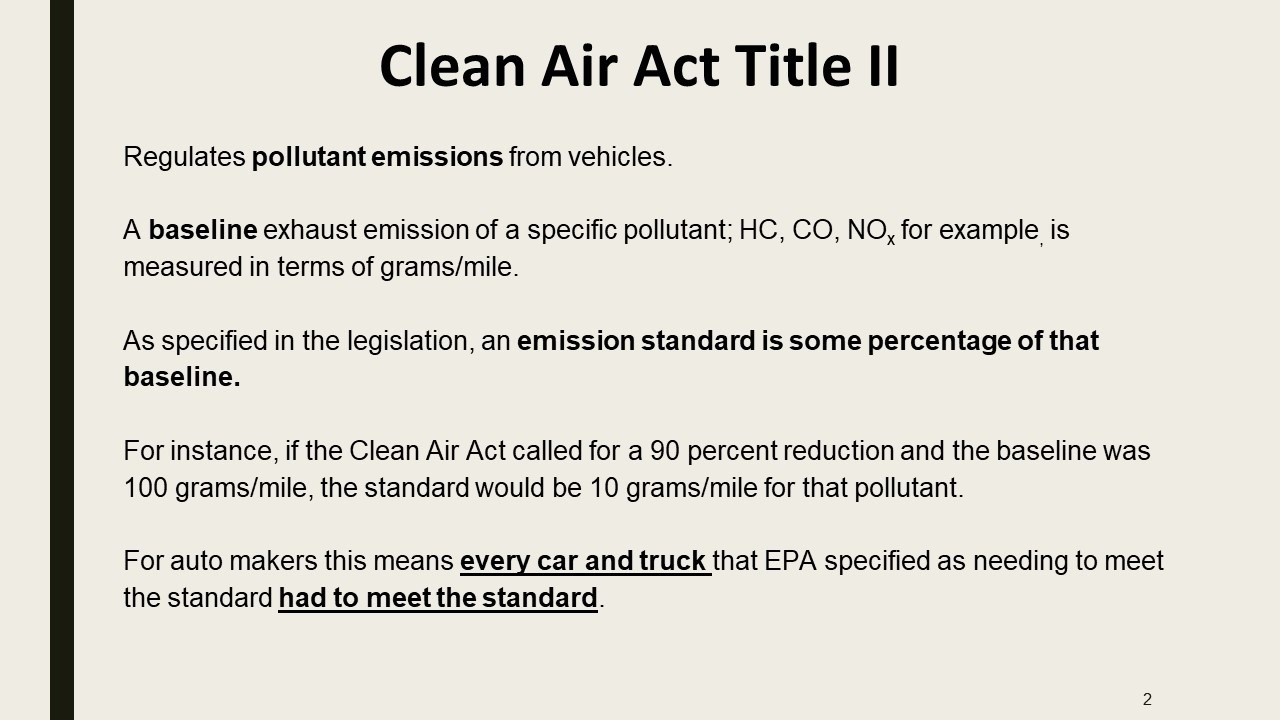
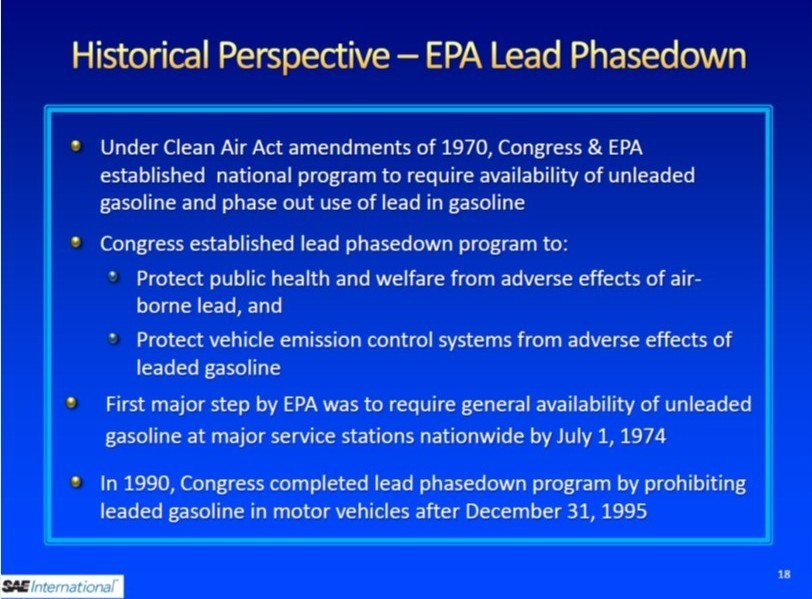
.jpg)





0 COMMENTS
Leave A Comment
Your Email Address wiil not be Published. Required Field Are marked*